人教版英语八年级下册unit1教案汇编
- 格式:doc
- 大小:90.50 KB
- 文档页数:8
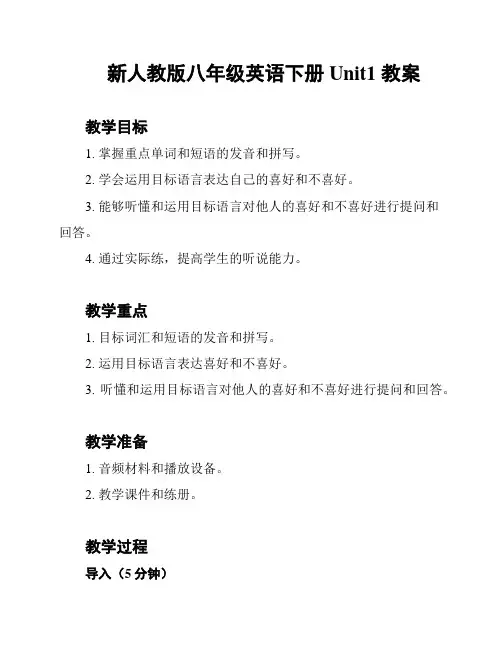
新人教版八年级英语下册Unit1 教案教学目标1. 掌握重点单词和短语的发音和拼写。
2. 学会运用目标语言表达自己的喜好和不喜好。
3. 能够听懂和运用目标语言对他人的喜好和不喜好进行提问和回答。
4. 通过实际练,提高学生的听说能力。
教学重点1. 目标词汇和短语的发音和拼写。
2. 运用目标语言表达喜好和不喜好。
3. 听懂和运用目标语言对他人的喜好和不喜好进行提问和回答。
教学准备1. 音频材料和播放设备。
2. 教学课件和练册。
教学过程导入(5分钟)1. 看图说词。
通过展示一些图片,帮助学生复并研究本单元的目标单词和短语。
2. 回答问题。
提问学生对于不同事物的喜好和不喜好,引出本单元的话题。
主体(30分钟)1. 听力训练。
播放目标语言对话或短文,要求学生听懂并回答相关问题。
2. 语法讲解。
介绍表达喜好和不喜好的目标语言结构,例如"I like..."和"I don't like..."。
3. 口语练。
进行口语练,让学生运用目标语言向他人询问和表达喜好和不喜好。
4. 配对练。
将学生分成小组,让他们根据提供的图片或提示进行对话练,表达彼此的喜好和不喜好。
5. 听力训练。
再次播放目标语言对话或短文,要求学生听懂并填写相关信息。
拓展(15分钟)1. 真实对话。
让学生以小组形式进行真实对话,互相了解彼此的喜好和不喜好。
2. 创作练。
要求学生根据自己的实际情况编写一篇关于自己喜好和不喜好的短文。
3. 分享和展示。
学生可以互相分享自己的短文,并选择几位同学进行展示。
小结(5分钟)1. 总结本节课研究的目标语言和知识点。
2. 引导学生反思研究效果,并给予相关鼓励。
教学反思本节课通过听说训练和实际练习,帮助学生掌握了目标词汇和短语的发音和拼写,并能够运用目标语言表达喜好和不喜好。
课堂中加入了互动的口语练习和小组活动,使学生积极参与,提高了听说能力和学习兴趣。
下一节课可以进一步拓展学生的应用能力,引导他们用目标语言进行更多的实际情境练习。
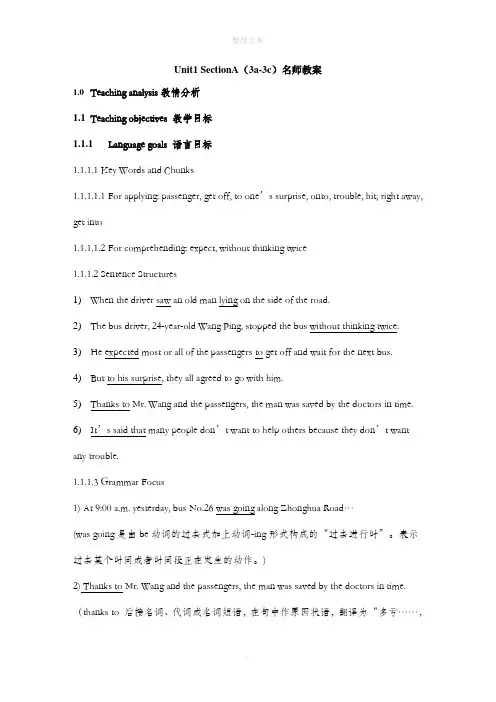
Unit1 SectionA(3a-3c)名师教案1.0Teaching analysis教情分析1.1Teaching objectives 教学目标1.1.1Language goals 语言目标1.1.1.1 Key Words and Chunks1.1.1.1.1 For applying: passenger, get off, to one’s surprise, onto, trouble, hit, right away, get into1.1.1.1.2 For comprehending: expect, without thinking twice1.1.1.2 Sentence Structures1)When the driver saw an old man lying on the side of the road.2)The bus driver, 24-year-old Wang Ping, stopped the bus without thinking twice.3)He expected most or all of the passengers to get off and wait for the next bus.4)But to his surprise, they all agreed to go with him.5)Thanks to Mr. Wang and the passengers, the man was saved by the doctors in time.6)It’s said that many people don’t want to help others because they don’t want any trouble.1.1.1.3 Grammar Focus1) At 9:00 a.m. yesterday, bus No.26 was going along Zhonghua Road…(was going是由be动词的过去式加上动词-ing形式构成的“过去进行时”。
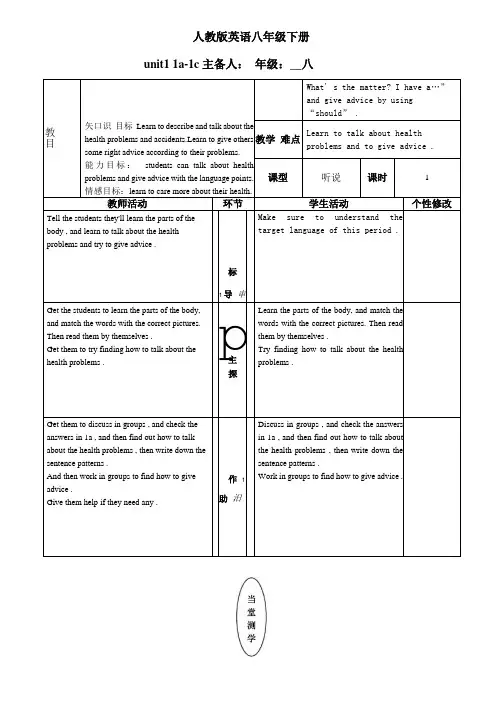
人教版英语八年级下册unit1 1a-1c 主备人:年级:__八学生课堂学习情况反馈教学反思学标教目矢口识目标Learn to describe and talk about the health problems and accidents.Learn to give others some right advice according to their problems.能力目标:students can talk about health problems and give advice with the language points.情感目标:learn to care more about their health.教师活动环节First have a dictation of the new words learned yesterday.Tell them they'll continue to learn how to talk about health problems and give advice .小标导J 审Ask the students to guess what 's the matter with the students in 2a .Then try to find the advice to differentproblems .Get them to translate the phrases . G 主探Play the recording and get them to finish 2a and 2b .Ask them to make conversations according to the listening material .1A作助 1审鬻What' s the matter? I have a…”and give advice by using“should” .教学难点Learn to talk about healthproblems and to give advice .课型听说课时 2学生活动个性修改Have a dictation of the new wordslearned yesterday.Go over the points learned yesterday .Guess what 's the matter with the studentsin 2a and write down .Find the advice to different problems .Translate the phrases .Finish 2a and 2b .Make conversations according to thelistening material .学生课堂学习情况反馈教学反思学科英语课题《unitl 2d , 4b》主备人:年级:__八学标教目知识目标:Learn to give others some right advice according to their problems.能力目标:Enable students to talk about health problems and give advice with the language points.情感目标:Students care more about themselves and their family members ' health.教师活动环节Tell them that they'll continue to learn how totalk about health problems and give advice.Today they'll learn a conversation and talkabout health problems.标1导刘Ask the students to read the dialogue bythemselves , underline the new words and thewords they don't know.Get them to answer the questions given by the teachers. G 主探Get them to work together and find out theanswers according to the conversation. Then role play the conversations. A作助旧教学重点Learn to talk about healthproblems by using “What' s thematter? I have a …” and giveadvice by using “should”.教学难点Learn to give appropriate adviceto the certain health problems.课型听说课时 3学生活动个性修改Continue to learn how to talk abouthealth problems and give advice.Learn a conversation and talk about health problems.Read the dialogue by themselves ,underline the new words and the wordsthey don't know.Answer the questions given by theteachers.work together and find out the answersaccording to the conversation.Then role play the conversations.学生课堂学习情况反馈教学反思学科英语课题《unit 1 grammar-4b》主备人:年级:_八学科英语课题《unitl section B 1a- 1c》主备人:年级:_八教学资源(含自编习题、阅读文章、听力资料、知识链接等)学科英语课题《unitl section B 2b-2e》主备人:_年级:_八学科英语课题《unitl self check》主备人:_年级:_八__。
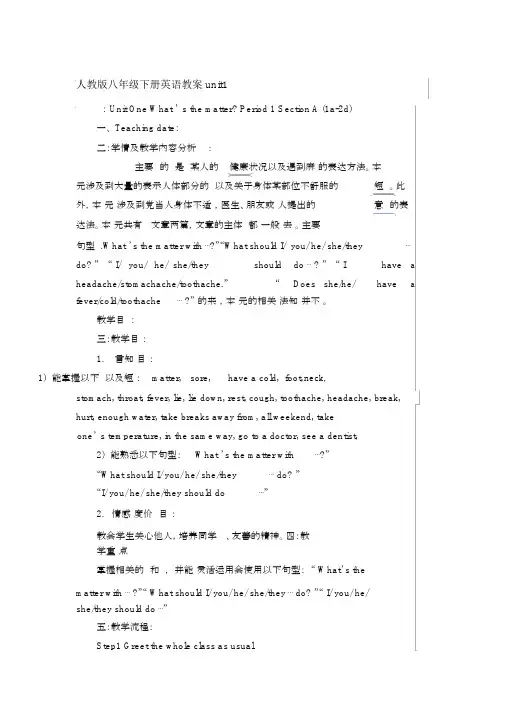
人教版八年级下册英语教案unit1: Unit One What ’ s the matter? Period 1 Section A (1a-2d)一、 Teaching date:二:学情及教学内容分析:主要的是某人的健康状况以及遇到麻的表达方法。
本元涉及到大量的表示人体部分的以及关于身体某部位不舒服的短。
此外,本元涉及到党当人身体不适,医生、朋友或人提出的意的表达法。
本元共有文章两篇,文章的主体都一般去。
主要句型 .What ’s the matter with ⋯?”“What should I/ you/ he/ she/they⋯do? ” “ I/ you/ he/ she/they should do ⋯ ? ” “ I have aheadache/stomachache/toothache.”“Does she/he/have afever/cold/toothache⋯ ?” 的来,本元的相关法知并不。
教学目 :三:教学目:1.言知目:1) 能掌握以下以及短:matter, sore, have a cold, foot,n eck,stomach, throat, fever, lie, lie down, rest, cough, toothache, headache, break,hurt, enough water, take breaks away from, all weekend, takeone’ s temperature, in the same way, go to a doctor, see a dentist,2) 能熟悉以下句型:What ’s the matter with⋯?”“What should I/ you/ he/ she/they⋯do?”“I/ you/ he/ she/they should do⋯”2.情感度价目:教会学生关心他人,培养同学、友善的精神。
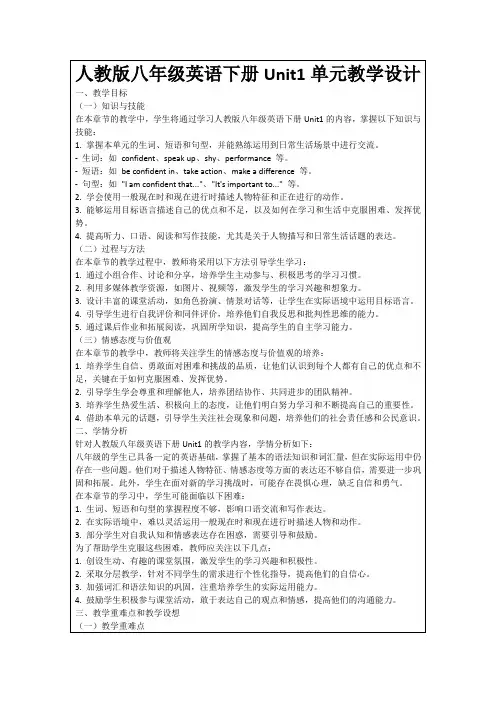

人教版八年级英语下册-Unit1-教案教学目标- 学生能够掌握并正确运用本单元的词汇和短语。
- 学生能够熟练运用本单元所学的句型进行口语表达。
- 学生能够通过阅读和听力理解本单元的相关话题。
- 学生能够参与到小组讨论和角色扮演的活动中,进一步提高口语交流能力。
教学内容一、词汇本单元重点词汇和短语包括:environmental, influence, pollution, reduce, recycle, waste, energy, natural resources, electric, appliance等。
二、语法本单元主要研究以下句型:1. It's important to + 动词。
例如:It's important to protect the environment.2. What should/could we do to + 动词?例如:What should we do to reduce pollution?三、听说读写通过听力活动和阅读材料,让学生了解有关环境保护的知识,并提高他们的听说读写能力。
四、口语交流组织小组讨论和角色扮演的活动,让学生通过对话的方式进行口语练,提高他们的口语交流能力。
五、拓展活动邀请环保专家或相关领域的人士来学校进行讲座,让学生进一步了解环保知识,并激发他们保护环境的意识和行动。
教学步骤第一课时1. 导入新课,介绍本单元的话题。
2. 学生听音,跟读词汇和短语。
3. 听力练,让学生根据听到的对话内容选择正确的图片。
4. 提出问题,让学生讨论并说出不同的解决办法。
第二课时1. 复上节课的内容,让学生回顾所学的词汇和句型。
2. 阅读活动,让学生阅读课文,并回答相关问题。
3. 角色扮演,让学生根据课文中的对话内容进行角色扮演。
第三课时1. 复上节课的内容,进行口头测试,检查学生对所学内容的掌握情况。
2. 小组讨论,让学生分组讨论如何保护环境,并给出建议。
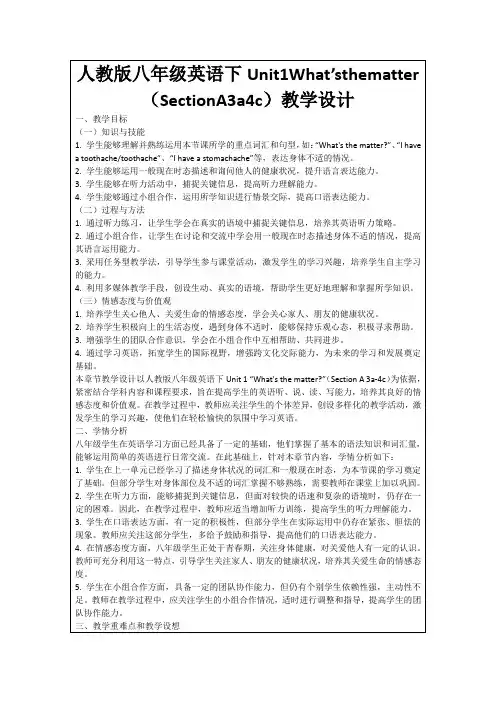
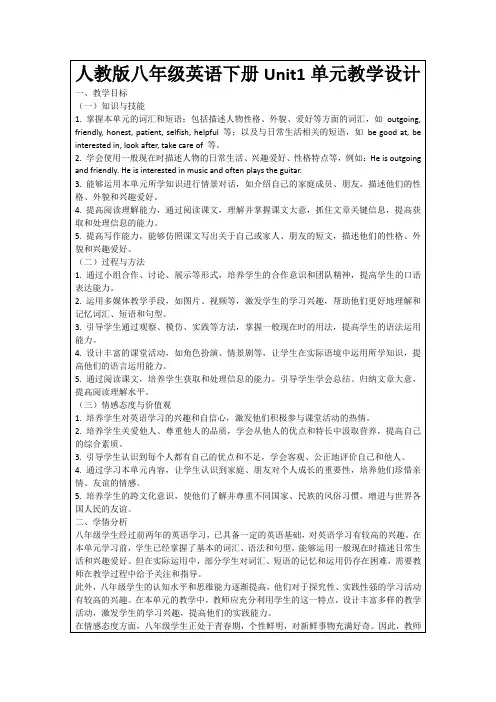
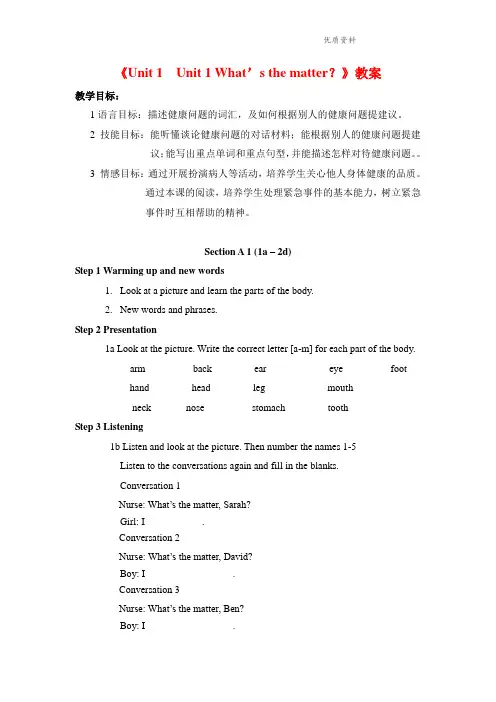
《Unit 1 Unit 1 What’s the matter?》教案教学目标:1语言目标:描述健康问题的词汇,及如何根据别人的健康问题提建议。
2 技能目标:能听懂谈论健康问题的对话材料;能根据别人的健康问题提建议;能写出重点单词和重点句型,并能描述怎样对待健康问题。
3 情感目标:通过开展扮演病人等活动,培养学生关心他人身体健康的品质。
通过本课的阅读,培养学生处理紧急事件的基本能力,树立紧急事件时互相帮助的精神。
Section A 1 (1a – 2d)Step 1 Warming up and new words1.Look at a picture and learn the parts of the body.2.New words and phrases.Step 2 Presentation1a Look at the picture. Write the correct letter [a-m] for each part of the body.___arm ___ back ___ ear ___ eye ___ foot___hand ___ head ___ leg ___ mouth___ neck ___nose ___ stomach ___ toothStep 3 Listening1b Listen and look at the picture. Then number the names 1-5Listen to the conversations again and fill in the blanks.Conversation 1Nurse: What’s the matter, Sarah?Girl: I ___________.Conversation 2Nurse: What’s the matter, David?Boy: I _________________.Conversation 3Nurse: What’s the matter, Ben?Boy: I _________________.Conversation 4Nurse: What’s the matter, Nancy?Girl: I _________________.Conversation 5Betty: What’s the matter, Judy?Ann: She __________________.Step 4 Speaking1c Look at the pictures. What are the students’ problems? Make conversati ons.ExamplesA: What’s the matter with Judy?B: She talked too much yesterday and didn’t drink enough water.She has a very sore throat now.A: What’s the matter with Sarah?B: She didn’t take care of herself on the weekend. She was p laying withher friends at the park yesterday. Then it got windy, but she didn’t puton her jacket. Now she has a cold.Step 5 Guessing gamesGuess what has happened to the students by using the important sentenc es. Step 6 Listening2a Listen and number the pictures [1-5] in the order you hear them.2b Listen again. Match the problems with the advice.Step 7 Speaking2c Make conversations using the information in 2a and 2bA: What’s the matter?B: My head feels very hot.A: Maybe you have a fever.B: What should I do?A: You should take your temperature.Step 8 Role–playImagine you are the school doctor. A few students have health problems.Role-play a conversation between the doctor and the students.2d Role –play the conversationStep 9 Language points and summary1. What’s the matter?这是人们特别是医生和护士询问病人病情时最常用的问句, 意思是“怎么了?”其后通常与介词with连用。
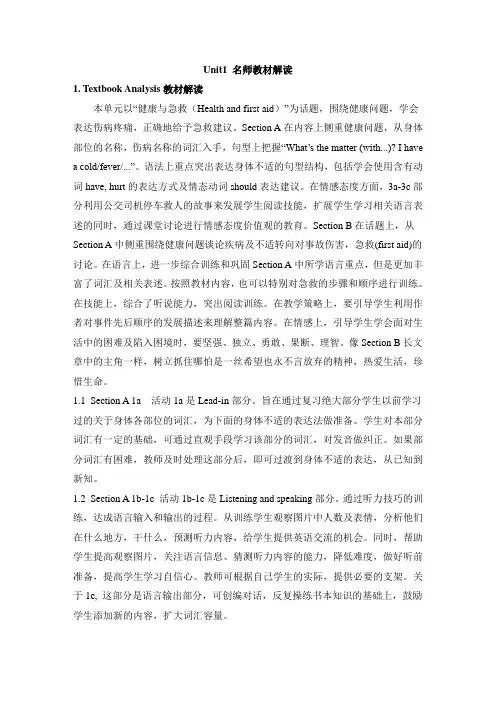
Unit1 名师教材解读1. Textbook Analysis教材解读本单元以“健康与急救(Health and first aid)”为话题,围绕健康问题,学会表达伤病疼痛,正确地给予急救建议。
Section A在内容上侧重健康问题,从身体部位的名称,伤病名称的词汇入手,句型上把握“What’s the matter (with...)? I have a cold/fever/...”。
语法上重点突出表达身体不适的句型结构,包括学会使用含有动词have, hurt的表达方式及情态动词should表达建议。
在情感态度方面,3a-3c部分利用公交司机停车救人的故事来发展学生阅读技能,扩展学生学习相关语言表述的同时,通过课堂讨论进行情感态度价值观的教育。
Section B在话题上,从Section A中侧重围绕健康问题谈论疾病及不适转向对事故伤害,急救(first aid)的讨论。
在语言上,进一步综合训练和巩固Section A中所学语言重点,但是更加丰富了词汇及相关表述。
按照教材内容,也可以特别对急救的步骤和顺序进行训练。
在技能上,综合了听说能力,突出阅读训练。
在教学策略上,要引导学生利用作者对事件先后顺序的发展描述来理解整篇内容。
在情感上,引导学生学会面对生活中的困难及陷入困境时,要坚强、独立、勇敢、果断、理智。
像Section B长文章中的主角一样,树立抓住哪怕是一丝希望也永不言放弃的精神,热爱生活,珍惜生命。
1.1Section A 1a 活动1a是Lead-in部分。
旨在通过复习绝大部分学生以前学习过的关于身体各部位的词汇,为下面的身体不适的表达法做准备。
学生对本部分词汇有一定的基础,可通过直观手段学习该部分的词汇,对发音做纠正。
如果部分词汇有困难,教师及时处理这部分后,即可过渡到身体不适的表达,从已知到新知。
1.2Section A 1b-1c 活动1b-1c是Listening and speaking部分。
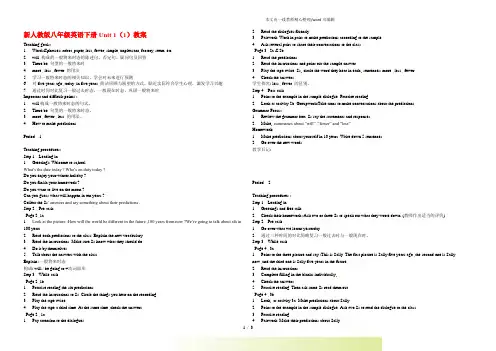
新人教版八年级英语下册Unit 1(1)教案Teaching goals:1. Words&phrases: robot, paper, less, fewer, simple, unpleasant, factory, seem, etc .2. will 构成的一般将来时态的陈述句、否定句、疑问句及回答.3. There be 句型的一般将来时.4. more , less , fewer 的用法.5. 学习一般将来时态的相关知识,学会对未来进行预测.6. 对five years ago ,today ,in five years 简洁回顾与展望的方式,贴近实际符合学生心理,激发学习兴趣.7. 通过时间对比复习一般过去时态、一般现在时态,巩固一般将来时.Important and difficult points :1. will构成一般将来时态的句式。
2. There be 句型的一般将来时态。
3. more , fewer , less 的用法。
4. How to make predictions .Period 1Teaching procedures:Step 1 Leading in1. Greetings: Welcome to sc hool .What’s the date today ? Who’s on duty today ?Do you enjoy your winter holiday ?Do you finish your homework ?Do you want to live on the moon ?Can you guess what will happen in ten years ?Collect the Ss’ answers and say something about their predictions .Step 2 Pre-taskPage 2 ,1a .1. Look at the picture :How will the world be different in the future ,100 years from now ?We’re going to talk about sth in 100 years .2. Read each predictions to the class .Explain the new vocabulary .3. Read the instructions .Make sure Ss know what they should do .4. Do it by themselves .5. Talk about the answers with the class .Explain :一般将来时态构成: will / be going to +动词原形Step 3 While-taskPage 2 ,1b .1. Practise reading the six predictions .2. Read the instructions to Ss .Circle the things you hear on the recording .3. Play the tape twice .4. Play the tape a third time .At the same time ,check the answers .Page 2 , 1c .1. Pay attention to the dialogues .2. Read the dialogues fluently .3. Pairwork .Work in pairs to make predictions according to the sample .4. Ask several pairs to share their conversations to the class .Page 3 , 2a & 2b .1. Read the predictions .2. Read the instructions and point out the sample answer .3. Play the tape twice .Ss circle the word they hear in each sentences: more , less , fewer .4. Check the answers .学生探究: less , fewer 的区别。
Unit 1 What's the matter?第一课时Section A (1a2d)【教学目标】1.重点单词:matter,back,sore,throat,stomachache,foot,neck,stomach,fever,lie,rest,cough,Xray,toothache,headache2 重点短语:have a sore throat,have a stomachache,have a cold,lie down,take one's temperature,have a fever,go to a doctor3 重点句式:—What's the matter?—She talked too much yesterday and didn't drink enough water.She has a very sore throat now.You should drink some hot tea with honey.It doesn't sound like you have a fever.You need to take breaks away from the computer.I think I sat in the same way for too long without moving.If your head and neck still hurt tomorrow,then go to a doctor.【学习重点】1 重点短语和句型2 询问对方身体状况的句型及答语【学习难点】询问对方身体状况的句型及答语【自主学习】一、预习课本P12新单词并背诵,完成下面的汉译英。
1 问题____________ 2.背部____________3 疼痛的____________ 4.嗓子____________5 胃痛____________ 6.脚____________7 脖子____________ 8.胃____________9 发烧____________ 10.平躺____________11 休息____________ 12.咳嗽____________13 X光____________ 14.牙疼____________15 头疼____________二、认真预习1a2d找出下列短语和句型。
Unit 1 What’s the matter?Section A (1a—2d)一、教学目标1. 能够熟练掌握本课重点词汇:matter, sore, stomachache, foot, neck, stomach, throat, fever, lie, rest, cough, X-ray, toothache, break, hurt,have a cold, have a stomachache, have a sore back, havea sore throat, lie down, cut oneself, take one’s temperature, have a fever, take breaks等。
2. 熟练运用本课重点句型:(1) —What’s the matter?—I have a…(2) —What should I do?—I think you should lie down and rest.3. 能够听懂谈论健康问题的对话,并能从中提取关键信息。
4. 能够使用“have+(a)+疾病”结构描述健康问题,并能就健康问题提出简单的建议。
5. 学会关心自己和他人,通过询问他人的健康情况并给予帮助,从而增进人与人之间的感情。
二、教学重点及难点重点:1. 能够听懂谈论健康问题的对话,并能从中提取关键信息。
2. 能够使用“have+(a)+疾病”结构描述健康问题,并能就健康问题提出简单的建议。
难点:能够使用“have+(a)+疾病”结构描述健康问题,并能就健康问题提出简单的建议。
三、教学过程四、板书设计Unit 1What’s the matter?第1课时Section A (1a—2d)Key words and phrases: matter, sore, stomachache, foot, neck, stomach, throat, fever, lie, rest, cough, X-ray, toothache, break, hurt,have a cold, have a stomachache, have a sore back, have a sore throat, lie down, cut oneself, take one’s temperature, have a fever, take breaksKey sentences:1. —What’s the matter?—I have a…2. —What should I do?—I think you should lie down and rest.。
Unit1 What's the matter?1. KnowledgeWords: have, cold, back, arm, ear, eye, foot, hand, head, leg, mouth, neck, nose, tooth, fever, rest, should, headache, ago, so, illness, thirsty, early, problem, way, traditional, believe, weak, angry, medicine, western, everybody, get, few, stay, important, moment, late, until, yesterday, hearPhrases: have a cold, be stressed out, a few, at the moment Structures: Have for talking about health problems.Modal: should / shouldn 't2. SkillsTalk about your health.Give advice.3. Learning Strategies Using what you know. Inferring content.II. BackgroundIII. Teaching Time: Six PeriodsPeriod OneTeaching Aims:1. Learn and master the following words and phrases: matter, have, cold, have a cold, stomachache, sore, back, arm, ear, foot, hand, head, leg, mouth, neck, nose, stomach, tooth, throat2. Develop the students'listening ability.3. Be able to talk about health.4. Sentence PatternsWhat 's the matter? I have a sore throat.Teaching Difficult Point The sentence patterns.Teaching Methods Listening practice to train the students 'listening ability.PairwrokTeaching AidsSome pictures.A tape recorder. Teaching ProceduresStep I Greetings.Step II. 1aTeach the students to study the new words by showing some pictures.eye, nose, mouth, ear, tooth, face, head, neck, back, stomach, arm, hand, leg, footAsk a student to read the list of thirteen names of body parts.Then let the students look at the picture and write the correct letter for each part of the body. Check the answers. Answers:k arm c back g ear i eye m foot a hand l head b leg f mouth e tooth d neck j nose h stomach Step III 1bShow some illnesses.e.g. I have a cold. I have a stomachache. Let several students say some illnesses.Ask a student to read the names. Nancy, Sarah, David, Ben, JudyThen play the recording the first time. Students only listen. Play the recording a second time. Students number the names. Cheek the answersAnswers:Nancy = 3 Sarah = 1 David = 2 Ben = 5 Judy = 4Step IV 1cAsk two students to read the conversation.A: What 's the matter?B: I have a sore throat.Then let the students make conversations in pairs.After some minutes, ask several pairs to say their conversations.Explain the language points.1. What 's the matter? 你怎么啦?这句话在口语中很常见,当别人遇到什么麻烦,或身体不舒服,你就可以问What ' the matter?意思是你怎么啦?/ 你遇到什么麻烦啦?/ 你哪儿不舒服?还可以在句末用介词with 表示对象。
新人教版八年级英语下册《Unit 1》教案一. [话题](Topic)health二.[重点词组](Key Phrases)have a cold患感冒stressed out 紧张的,有压力的bean sprout豆芽get tired感觉疲惫stay healthy保持健康at the moment此刻,现在on the other hand另一方面get a cold患感冒see a dentist看牙医go to the party去参加聚会make sick使某人不舒服(患锁病)have a sore throat嗓子痛have a fever发烧,发热have a toothache牙痛have a backache背痛have a headache头痛三.[交际用语]1 关心别人:你怎么啦?What’s the matter?What’s the matter with you?What’s wrong?What’s wrong with you?2 关心别人:你是不是得……(病)了呀?Do you have a fever?Are you hungry?3 关心别人:你应该……,你最好……,为什么……?You should go to bed early.You shouldn’t eat anything for 24 hours.You’d better go to bed early.You’d better not eat anything for 24 hours.Why not go to bed early?Why don’t you go to bed early?4 关心自己:我不舒服,我病了,我饿了I’m not fe eling well.I have a headache.I am hungry.四. [重点难点释义](Language Points)1.What's the matter, Judy?朱迪,你哪里不舒服?(你怎么了?)matter n.问题,麻烦,事件,通常与介词“with”连用:What's the matter with him?他怎么了?这个句型可以与下面这两个句子互换:What's wrong with him?What's the trouble with him?wrong是形容词,前面没有“the”; matter和trouble都是名词,前面应有“the”, trouble前还可以用形容词性的物主代词。
Unit1 What’s the matter?1. KnowledgeWords: have, cold, back, arm, ear, eye, foot, hand, head, leg, mouth, neck, nose, tooth, fever, rest, should, headache, ago, so, illness, thirsty, early, problem, way, traditional, believe, weak, angry, medicine, western, everybody, get, few, stay, important, moment, late, until, yesterday, hearPhrases: have a cold, be stressed out, a few, at the momentStructures: Have for talking about health problems.Modal: should / shouldn’t2. SkillsTalk about your health.Give advice.3. Learning StrategiesUsing what you know.Inferring content.II. BackgroundIII. Teaching Time: Six PeriodsPeriod OneTeaching Aims:1. Learn and master the following words and phrases: matter, have, cold, have a cold, stomachache, sore, back, arm, ear, foot, hand, head, leg, mouth, neck, nose, stomach, tooth, throat2. Develop the students’ listening ability.3. Be able to talk about health.4. Sentence PatternsWhat’s the matter? I have a sore throat.Teaching Difficult PointThe sentence patterns.Teaching MethodsListening practice to train the students’ listening ability.PairwrokTeaching AidsSome pictures.A tape recorder.Teaching ProceduresStep I Greetings.Step II. 1aTeach the students to study the new words by showing some pictures.eye, nose, mouth, ear, tooth, face, head, neck, back, stomach, arm, hand, leg, footAsk a student to read the list of thirteen names of body parts.Then let the students look at the picture and write the correct letter for each part of the body.Check the answers.Answers:k arm c back g ear i eye m foot a hand l head b leg f mouth e tooth d neck j nose h stomach Step III 1bShow some illnesses.e.g. I have a cold. I have a stomachache. Let several students say some illnesses.Ask a student to read the names. Nancy, Sarah, David, Ben, JudyThen play the recording the first time. Students only listen. Play the recording a second time. Students number the names. Cheek the answersAnswers:Nancy = 3 Sarah = 1 David = 2 Ben = 5 Judy = 4Step IV 1cAsk two students to read the conversation.A: What’s the matter?B: I have a sore throat.Then let the students make conversations in pairs.After some minutes, ask several pairs to say their conversations.Explain the language points.1. What’s the matter? 你怎么啦?这句话在口语中很常见,当别人遇到什么麻烦,或身体不舒服,你就可以问What’s the matter?意思是你怎么啦?/ 你遇到什么麻烦啦?/ 你哪儿不舒服?还可以在句末用介词with表示对象。
e.g. —What the matter with you? 你怎么啦?—I can’t find my ticket. 我打不到我的票。
—What’s the matter with your car? 你的车怎么啦?—I can’t start it. 它发动不了了。
2. “have + a +疾病名”表示“患……(病)。
”have a cold (患)感冒have a stomachache 胃痛have a sore back 背痛have a toothache (患) 牙痛have a sore throat (患)咽喉痛have a fever 发烧,发热have a headache (患)头痛have a backache 背痛Step V Summary and HomeworkSummarize what the students have learnt and give them some homework.To make conversations in 1c in pairs.To do some exercises.Period TwoTeaching Aims1. Learn and master the following words: toothache, fever, rest, honey, dentist, should, headache, shouldn’t= shouldnot2. Develop the students’ listening ability.3. Be able to give advice.4. Sentence PatternsWhat’s the matter? I have a toothache.Maybe you should see a dentist. That’s a good idea.He has a stomachache. He shouldn’t eat anything.She has a toothache. She should see a dentist.Teaching Difficult PointThe sentence patterns.Teaching methodsListening practice to train the students’ listening ability.PairworkTeaching AidsA tape recorder.A projector.Teaching Procedures.Step I. Greetings.Step II. RevisionAsk several pairs of students to say their conversations.Do some exercises.写出人体各部分的英语名称。
Step III. 2aTeach the students to study the new words by a projector.toothache n. 牙痛fever n. 发烧;发热rest n. 休息honey n. 蜂蜜dentist n. 牙医should v. 应该headache n. 头痛shouldn’t = should notAsk a student to read the eight items to the class:fever, sore throat, stomachache, toothache, lie down and rest, hot tea with honey, see a dentist, drink lots of waterThen play the recording the first time. Students only listen.Play the recording a second time. Students match the problems with the advice.Check the answers.Step IV 2bAsk the students to look at the pictures. Ask, what can you see in the pictures?Then play the recording again. Ask the students to fill in the blanksCheck the answersStep V 2cAsk two students to read the conversation.A: What’s the matter?B: I have a toothache.A: Maybe you should see a dentist.B: That’s a good idea.Then let the students make conversations in pairs.After some minutes, ask several pairs to say their conver sations.Explain the language point.Maybe you should see a dentist.Step VI Grammar FocusAsk the students to read the sentences.I have a headache. You should go to bed.He has a stomachache. He shouldn’t eat anything.She has a toothache. She should see a dentist.Then let the students make similar sentences.Step VII. Summary and HomeworkSummarize what the students have learnt and give them some homework.To remember the grammar focus.Period ThreeTeaching Aims:1. Learn and master the following words: ago, so, illness, advice2. Sentence PatternsWhat’s the matter? I’m not feeling well. I have a cold.When did it start? About two days ago.Oh, that’s too bad. You should get some rest.Yes, I think so. I hope you feel better soon.3. Review how to talk about health and give advice.Teaching Difficult PointThe sentence patterns.Teaching MethodsPairwork.Groupwork.Teaching AidA projector.Teaching ProceduresStep I. Greetings.Step II. RevisionStep IV 3bAsk the students to read the conversations in 3a in pairs.After some minutes, ask several pairs to say the conversations.Then let the students look at the picture. Ask, what’s the mater with the people in the picture?(He has a toothache. She has a sore back. He has a sore throat. She has a stomachache.)After some minutes, ask several pairs to say their conversations.Step V 4Read the conversation to the class.A: What’s the matter? Do you have a sore throat?B: No, I don’t.C: Do you have a headache?B: Yes, I do.D: You should lie down and rest.Read the instructions and demonstrate what a “mime” is.e.g. Hold your tooth as if you have a toothache. Say, I’m miming a toothache.Ask a student to the classroom of the from and mime an illness. Let the rest of the class guess what the illness is. Give several students an opportunity to come to the front and mime an illness.Step VI Summary and HomeworkSummarize what the students have learnt and give them some homework.To make conversations in 3a in pairs.Period FourTeaching Aims:1. Learn and master the following words:thirsty, early, problem2. Sentence PatternsWhat’s the matter with Gina? She’s tired. She should go to bed early.She shouldn’t go to the party.3. Review how to talk about health and give advice.Teaching Difficult Point.The Sentence Patterns.Teaching Methods.Listening practice to train the students’ listening abilityPairworkTeaching ProceduresStep I Greetings.Step II Revision.Step III 1aAsk the students the four new words and look at the picture.Ask. What are they doing?Let some students answer the questions, then read it.Then let students fill in the blanks.Check the answers.Step IV 1bLet students read the four sentences then read each one again and ask students to repeat the sentences. Listen to the tape. Then let students match each pictureWith one piece of advice. Write the letter of the picture in front of the sentence that gives advice.Correct the answers.Step V 2aLet students look at the chart. Then ask the students listen to the four conversations. Write the problems in the blanks after each person’s name.Correct the answers.AnswersGina: tired Julie: thirstyTony: stressed out Alan: hungryStep VI 2bLet students listen to the four conversations again. Then write what each person should and shouldn’t do for their problems.Answers.Step VII 2cFirst let two students to read the conversation.A: What’s the matter with Gina?B: She’s tired.A: Well, she should go to bed.She shouldn’t go to the party.Let students use the information in Activity 2a to make conversations. Then ask some pairs to perform their conversaions for the class.Step VIII Summary and Homework.Summarize what the students have learnt and give them some homework.To make conversations in 2c in pairs.Period FiveTeaching Aims:Learn and master the following words and phrases way, traditional, believe, weak, angry, medicine, western, everybody, get, few, stay, importantSentence patterns①Traditional Chinese doctors believe we need a balance of yin and yang to be healthy.②Eating Dangshen and Huangqi herbs is also good for this .③It’s easy to have a healthy lifestyle.④People who are too stressed out and angry may have too much yang.Teaching Difficult Point.The sentence patterns.Teaching Methods.Reading practice to train the students’ reading ability. Writing practice to train the students’ writing ability.Teaching AidA projector.Teaching procedures.Step I GreetingStep II New wordsTeach the students to study the new words by a projectorway n. 方法,方式traditional adj. 传统的,惯例的believe v. 相信,认为weak adj. 虚弱的angry adj. 愤怒的,生气的medicine n. 药western adj. 西方的everybody 每人pron get v. 变得few adj. 很少的,几乎没有的stay v. 保持important adj. 重要的Step III 3aRead the article. Then Explain the language points.1. Traditional Chinese doctors believe we need a balance of … Chinese doctors believe that they should eat …在这两个句子中,believe后跟的都是宾语从句,都由that引导,that可以省略。